simon morley, "classic japanese movies"Mar. 17 - Apr. 21, 2007 taguchi fine art, ltd. |
|
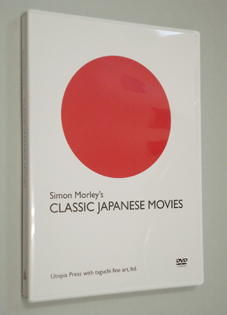
catalogue 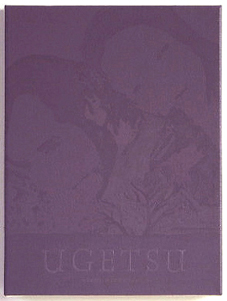
"Ugetsu" by Kenji Mizoguchi 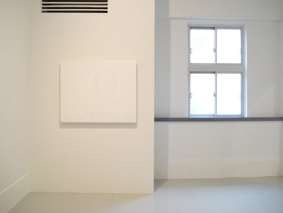
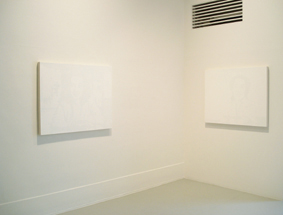
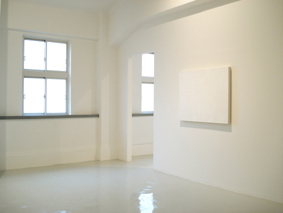
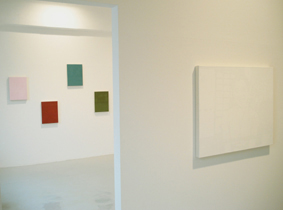
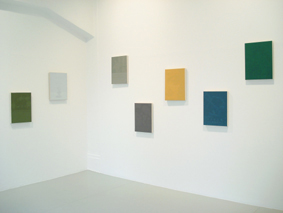
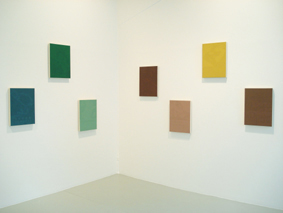
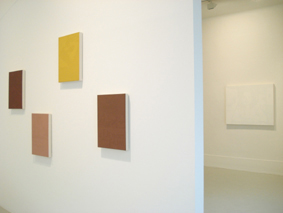
|
Simon Morley was born in Eastbourne, England in 1958. Got BA of modern history at Mansfield college, Oxford University in 1980 and MA of fine art at Goldsmith's college, University of London in 1998. Based in Allier in France and Kent in England, participates artist-in-residence in various places as the Wordsworth Trust in Grasmere, the British School in Rome, and Centre d'art contemporain de Pougues-les-Eaux in France. Besides creating art works, he also curates exhibitions and writes essays in art journals. He is an author of a study on art history, "Writing on the Wall - Word and Image in Modern Art, Thames and Hudson, 2003". Word and ImageHis work always deals the relation between word and image as: "VIRUS" - certain word is painted in characteristic type (each type has historical meaning) in front of its background with randomly floating multicoloured letters, "signature painting" - a signature by prominent figure is enlarged and painted on the wall of certain place to which the person has relation, "label painting" - hand painted labels to explain works displayed at an exhibition, "book painting" - cover or title page of a book is transcribed on canvas, "postcard painting" - postcards collected from bric-a-brac shops are reproduced on canvas, a work in which photographs of gravestones and words from poems are combined into pairs, a video work showing 10 different mouths saying the last lines of Wordsworth's poem in slow motion without sound, and books published by imaginary publisher, Utopia Press. This time Morley created DVD paintings which is a development from his book paintings.DVD paintingIn one group of works the style and packaging of video and DVD's of Japanese films destined for the Western market have been translated into the language of painting. The normal conventions of figure-ground contrast are replaced by more subtle variations between surface and text and image. These variations are composed of small shifts in colour hue and tone, and in differences in surface texture. As a result, the viewer/reader is obliged to engage in a more detailed and "quieter" mode of perception and cognition.Morely chose 15 Japanese movies for this project: "Late Spring", "Early Summer", "Tokyo Story", "Floating Weeds" by Yasujiro Ozu, "Rashomon", "Ikiru", "Seven Samurai", "Throne of Blood" by Akira Kurosawa, "The Lady of Musashino", "The Life of O-haru", "Ugetsu", "Sansho the Bailiff" by Kenji Mizoguchi, "Nuages flottants" by Mikio Naruse, "Woman in the Dunes" by Hiroshi Teshigahara and "Le detroit de la faim" by Tomu Uchida. His work as a whole is motivated by an interest in renewing the language of painting through an exploration what happens when certain dislocations occur between media and when new connections are made. In previous exhibitions he has broken text up into letter-fragments and made facsimile paintings of books. In working now with video and DVD packaging he is opening up his work to the image, incorporating not only text but also the pictures found on the packaging cases. He is interested in the way in which word and image interact and modify the ways we employ and understand different sign-systems. Here, the images we see are stills from the films themselves. But what has determined which particular still-image is chosen, or how they are made to interact with the typography? How is an image able to sum up or encapsulate a whole film? Noriko paintingIn the second group, "Noriko" paintings, based on film-stills taken from Yasujiro Ozu's great trilogy starring the actress Setsuko Hara as the character Noriko - "Late Spring", "Early Summer" and "Tokyo Story", Morley moves into more stridently visual territory. The still-images, grabbed from the films' thousands of frames, is reduced to a simple, abbreviated language of dark and light, flat and impasto.The near-whiteness renders the whole difficult to visualise, forcing the viewer to work more actively in order to turn raw perceptual information into a cogent sign. Here, white also signifies the qualities of negation, emptiness and void that lie at the heart of Ozu's work, qualities that are understood in the West as signifying a fundamental lack. In contrast, in traditional Eastern thinking, such qualities imply the untapped and untappable potential out of which all things come. In this context, the thick surfaces of the paintings suggest materiality, the present and tangible moment of the painting itself as an object through which the void may be perceived. checklist of the installation 1. Yasujiro Ozu, Late Spring, 1949 2006, acrylic on canvas 41 x 31 cm 2. Akira Kurosawa, Rashomon, 1950 2006, acrylic on canvas 41 x 31 cm 3. Kenji Mizoguchi, The Lady of Musashino, 1951 2007, acrylic on canvas 41 x 31 cm 4. Yasujiro Ozu, Early Summer, 1951 2006, acrylic on canvas 41 x 31 cm 5. Akira Kurosawa, Ikiru, 1952 2006, acrylic on canvas 41 x 31 cm 6. Kenji Mizoguchi, The Life of O-Haru, 1952 2006, acrylic on canvas 41 x 31 cm 7. Kenji Mizoguchi, Ugetsu, 1953 2006, acrylic on canvas 41 x 31 cm 8. Yasujiro Ozu, Tokyo Story, 1953 2006, acrylic on canvas 41 x 31 cm 9. Akira Kurosawa, Seven Samurai, 1954 2006, acrylic on canvas 41 x 31 cm 10. Kenji Mizoguchi, Sansho the Bailiff, 1954 2006, acrylic on canvas 41 x 31 cm 11. Mikio Naruse, Nuages flottants, 1955 2007, acrylic on canvas 41 x 31 cm 12. Akira Kurosawa, Throne of Blood, 1957 2006/7, acrylic on canvas 41 x 31 cm 13. Yasujiro Ozu, Floating Weeds, 1959 2006/7, acrylic on canvas 41 x 31 cm 14. Hiroshi Teshigahara, Woman in the Dunes, 1964 2006, acrylic on canvas 41 x 31 cm 15. Tomu Uchida, Le Detroit de la Faim, 1964 2006/7, acrylic on canvas 41 x 31 cm 16. Noriko from Late Spring 2006, acrylic on canvas 73 x 92 cm 17. Noriko from Early Summer 2007, acrylic on canvas 73 x 92 cm 18. Noriko from Tokyo Story 2006, acrylic on canvas 73 x 92 cm |